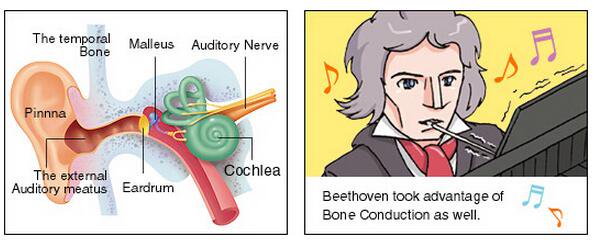Beethoven (nearly deaf) discovered bone conduction as a means to hear his piano by clenching a rod (attached to the piano) between his teeth
It was discovered by Ludwig van Beethoven in the 18th century. The famous composer has discovered that he can hear his compositions with a stick attached to his piano and that of the jawbone through his inner ear.
Beethoven found a way to hear the sound of the piano from the jawbone by attaching the metal rod to the piano and clamping his teeth.

Bone Conduction: How does it work?
We all hear voices through our bones (with bone or bone conduction) and through our eardrums (airborne or airborne). Most sounds are heard by our eardrum. The eardrum converts sound waves into vibrations and transmits them to the cochlea (or inner ear). However, in some cases, direct vibrations are heard by the inner ear by bypassing your eardrum. In fact, this is one way to hear your own voice. This is also how the whales hear.
The famous 18th-century composer Ludwig van Beethoven, who was almost completely deaf, discovered the Bone Conduction. Beethoven found a way to hear the sound of the piano from his jawbone by picking up a stick in his mouth and clenching his teeth. When the vibrations were transferred from the piano to his jaw, he got the perception of the sound. This has proven that the sound can reach our hearing system from other than the eardrum, and that the other vehicle is our bones.
How we usually hear
Normal sound waves are actually small vibrations in the air. Vibrations pass through the air in our ears. The eardrum vibrates by transforming these sound waves into a different kind of vibration received by Cochlea, also known as inner ear. Cochlea is bound to our auditory nerve that transmits the sounds to our brain.
How we feel with bone conduction
Bone conduction skips the eardrum. In listening to bone conduction, bone conduction devices (such as headphones) perform the role of your eardrum. These devices decode sound waves and convert them directly into vibrations that can be received by Cochlea, so the eardrum is never included. Ir Sound olarak reaches the ears as bones (or skull) and vibration through the skin.

The advantage for people with hearing loss
Most cases of hearing loss are caused by damage to the eardrum. Since the bone conduction does not use the eardrum, people with hearing difficulties may be able to hear again with bone conduction, provided their cochlea is in healthy and normal conditions. In general, hearing loss can be defined in three categories. This will be a conductive hearing loss, perceived hearing loss and mixed hearing loss. Conductive hearing loss is associated with erroneous sound transmission and is often caused by damage to the eardrum. A conduction of the bone conduction can aid hearing loss because a bone conducting device performs the role of the eardrum.


Comments